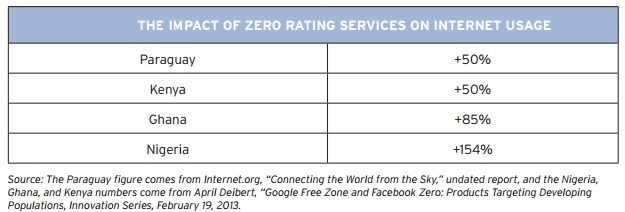Mobile adoption rates have exploded over the past ten years. The mobile phone revolution offers numerous benefits including positive effects on economic development, entrepreneurship, education, and health care. New programs in both the developed and undeveloped world have had success. But, these advances obscure challenges towards a long-term goal of universal Internet availability. In a recent paper Darrell West examines some of the economic and political factors that prevent an estimated 4.2 billion people from accessing the Internet.
Barriers to Internet access
In many countries – even among some of the world’s largest economies – there is a gap in Internet adoption between rural and urban areas. A lack of infrastructure is responsible in many cases for this divide. West describes how the lack of, “fiber optic lines, cell towers, Internet routers, wireless spectrum, [and] reliable electricity” can inhibit Internet proliferation.
There is considerable variation in Internet adoption among age groups. Seniors in many countries are much less likely to use the Internet. Many people particularly in rural areas lack literacy in addition to a general understanding of how to use a computer. Both factors create obstacles for potential new Internet users.
Many non-Internet users are also fearful of the technology. There is a general anxiety associated with learning how to use the Internet. Some also describe fear about 21st century threats like, “computer viruses, hacking, surveillance, or identity theft.”
Policies to mitigate the digital divide
1. Zero rating services
A lack of disposable income is a major factor that prevents many from gaining Internet access. Users must also pay for data in addition to the cost of a device. Zero rating services circumvent this barrier by providing access to applications that have no associated data costs. For example Wikipedia makes a zero rated version of their app available, which is free to use. This practice has huge potential to provide the benefits of the Internet to all people.

Source: The Digital Divide
2. Reducing taxes
Several countries have “connectivity taxes” on mobile and fixed Internet connections. These taxes drive up costs for consumers, which can make the Internet unaffordable for many families. In some cases it also reduces the incentives for Internet Service Providers to make infrastructure investments in underserved areas. Research has shown that reducing these types of taxes can increase the number of Internet users.
3. Diversifying content
English is the primary language of the Internet. This excludes millions of educated people who could use the Internet if content were available in their native tongue. Expanding the type of content on the Internet would also increase its attractiveness for people around the world. For example, Ghana’s CocoaLink project provides expert information to farmers through text messages. Useful services like these provide an incentive for new users.
The number of Internet users increases every year by hundreds of millions of people. However, the percent of worldwide Internet penetration has declined in 2013 from recent peaks. Fortunately there are a number of options available to governments who seek to mitigate barriers to Internet access for their poorest citizens. New policies are necessary to make sure that all people regardless of the socio-economic status have access to the benefits of the Internet.



Commentary
3 ways to provide Internet access to the developing world
March 2, 2015